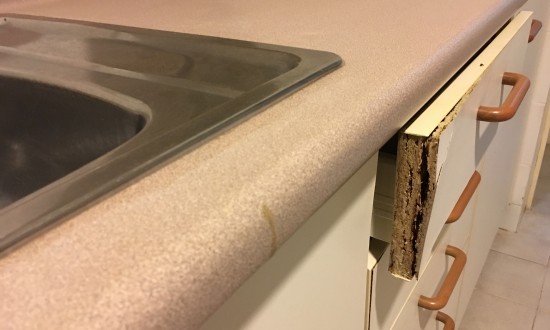Managing Carpentry Maintenance Chores
(1) Should tenants be held responsible for the “bloated” kitchen cabinet doors and table top?
What would you do as an owner when you inspect your investment properties during the Handover Session (Tenant-to-Owner) and you noticed your kitchen cabinet doors and table top are “bloated”?
Most owners would be upset to see such condition of the kitchen cabinets. Some of these kitchen cabinets may be newly installed by carpenters just before tenants move in. Should you deduct some money from the Security Deposit from the tenant? What should owners do?
What would you do as an owner when you inspect your investment properties during the Handover Session (Tenant-to-Owner) and you noticed your kitchen cabinet doors and table top are “bloated”?
Most owners would be upset to see such condition of the kitchen cabinets. Some of these kitchen cabinets may be newly installed by carpenters just before tenants move in. Should you deduct some money from the Security Deposit from the tenant? What should owners do?

It is obvious that such wooden sections are bloated because water has seeped into the woods over a period of time and the section expanded in size. For such kind of “bloated-ness”, no carpenters can “repair” nor “replace” only this section.
If the “bloated” section is the kitchen cabinet doors, carpenter can simply change the affected doors. Of course, to find the same pattern of kitchen cabinet doors with the same colour will be a challenge. Even if the carpenters can get the same colour with the exact colour code, new doors may not be 100% matching compared to other existing un-damaged doors due to ageing. Also, one thing to take note – most carpenters are not willing to take on such “small” jobs to replace 1-2 pieces of kitchen doors. If they do, the cost will be very high.
If the “bloated” section is the kitchen cabinet table top, then this is an even bigger problem. This is because kitchen cabinet table tops are usually made in one big piece (as long as 10-12 feet in some cases). To rectify, carpenters will have to replace the ENTIRE kitchen cabinet table top which is a big job you can imagine. Dismantling the existing table top may also damage all adjoining sections too. Obviously, the replacement of the entire kitchen cabinet table top would cost the owner a bomb.
For such “bloated-ness” especially those that are next the kitchen sink, most tenants would treat it as “wear and tear” while owners would put the blame on the tenants for splashing water outside of the kitchen sink when washing dishes.
Back to the question asked. Unfortunately for such “bloated-ness”, it is difficult for owners to show proof on how such damaged sections are created although the end-result is a very clear “bloated” piece of “evidence”. The ultimate decision lies with the owners. Some owners would waive out of goodwill while others may simply deduct a certain amount from the Security Deposit. At the end of the day, there are no perfect hard and fast rules to this issue. The only thing that can be done lies with the tenant, in hindsight, is to take better care of the kitchen cabinets during the period of the tenancy
If you need further clarification of the above issue, please contact us to find out more.
… continue reading 9 other Home Maintenance topics.

 Regn No.: 53333974W
Regn No.: 53333974W